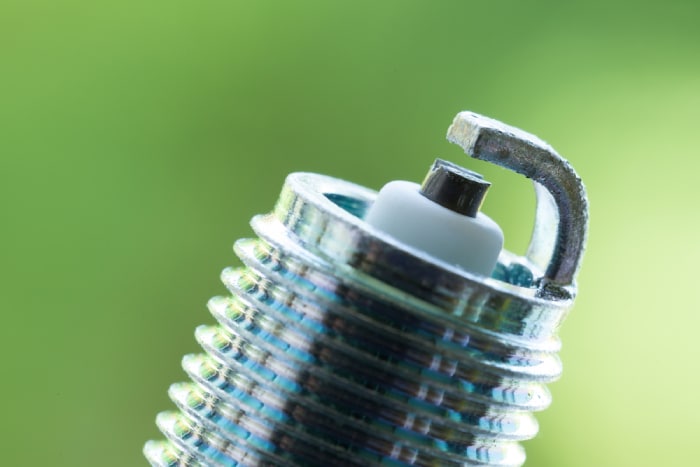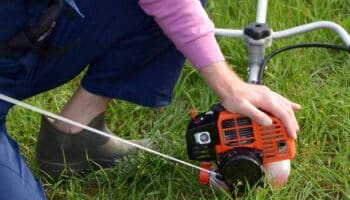Is your lawn mower stalling or cutting out?
We’re going to look at some common lawn mower issues that might cause this and what to do about it. We’ll look at the top three areas responsible for an engine cut-out and how to fix some of the most common issues.
By the end of this article, you will have learned what the most common issues are, how to diagnose them, and how to fix them.
So, if you have a lawn mower that runs for a while before dying, you’re in the right place. Read on for our fixing a grumpy lawn mower: no more stalls/engine cut-outs guide.
Safety
First, take a moment to think about safety. Wear gloves and safety glasses to protect your hands and eyes. And before you do anything to your lawn mower, always remove the electrical cap from the spark plug. That way, there is no chance of the engine turning over, the blades going round and you losing any fingers.
Whatever make and model you have, there are always minor differences. Make sure you read the owner’s manual and familiarize yourself with your particular mower.
And one final tip: if you have all the parts, tools, cleaning agents, and lubricants ready to go before you start, it makes life easier.
The top three reasons a lawn mower cuts out
There are several reasons a lawn mower might start and then stop. Most of them are relatively easy to fix. We’re going to start with the simplest and work our way towards some of the more complicated.
The top three reasons are:
- Fuel Issues
- Spark plug issues
- Carburetor issues
Fuel issues
Often a lawn mower cut-out is because of a fuel issue. If your mower has been standing unused for a while with some fuel in the tank, you should replace the gas. Most manufacturers will say that you shouldn’t use gas older than a month. While I find that a bit excessive, I would definitely not let gas stand in the tank of my mower over winter.
Old fuel can cause an issue for three primary reasons. Over time, the most volatile compounds in the fuel evaporate and leave behind a residue. This residue can gum up the carburetor and make your mower hard to start or stall.
Water will also condense in fuel over time. A buildup of water will cause your mower to jolt, sputter, and lose power. As well as the fuel residues, other contaminants may have gotten into your fuel. These can block the carburetor and cause a stall.
To troubleshoot a fuel issue:
- First, drain out the old gas. Either siphon the tank or remove the fuel line and allow the gas to drain. If you remove the fuel line, don’t forget to clamp it off before the carburetor. This will stop gas from leaking from the engine.
- Have a rag or absorbent paper towels ready to mob up the spills. Use suction to try to empty the tank as much as possible and pick up any contaminates or residues that may be left in the bottom. I’ve seen a tip that suggested using a turkey baster for this. Anything like that would be perfect.
- Before you add new fuel, it’s a good idea to check the fuel filter. This will either be in the bottom of the fuel tank or on the fuel line running from the tank. If it’s dirty, replace it. Otherwise, you can reuse it.
- Using a fuel stabilizer with the new gas will inhibit the formation of residue. Meaning you can leave the gas in the tank for longer. So, if you do need to leave the fuel in the tank or in (your jerry can) stabilizer is a good idea.
One final issue to check while inspecting the fuel is the fuel tank vent.
Sometimes the vent becomes blocked. This causes a vacuum in the tank and stops the fuel from flowing. Usually, the vent is integrated into the fuel cap and can be easily cleaned. If your cap is old or the vent is damaged, get a new fuel cap.
If you want to get any replacement part – or see how much one would cost – click to enter your model number in the search bar below. Our partners at AppliancePartsPros stock almost every part with free guides on how to install them.

Spark plug issues
Another possible issue that would cause your mower to stall is your spark plug. Spark plugs degrade over time and will need replacing regularly. I would recommend you check your plug at least once a year. And inspect it for dirt, damage, and distance.
Spark plugs that have been used for a while will accumulate build-up, and this needs to be cleaned off. Use a soft wire brush. If the head is damaged, missing, or corroded, you’re going to need to replace it.

If the electrode is damaged, you might want to investigate further as this could be a sign of a foreign body in the engine. If the spark plug is oily, it’s a sign that oil is leaking into the combustion chamber. This could be a more serious problem that needs investigating further.
If the spark plug looks fine, but you still suspect it might be an issue, check it’s sparking correctly. It is possible to get faulty spark plugs (even brand-new ones) so it’s worth checking.
Carburetor
A lot of your stalling issues will probably be related to the carburetor. And sometimes people get a little less confident in their ability to solve the problem when you mention the word carburetor. But don’t worry. It is simple and easy to clean, and if necessary replace parts or the whole thing.
The carburetor mixes air and fuel into the right proportions to make the combustible mixture that fires your engine. It draws air through a filter and gas from the tank. They are blended in the mixing chamber before being injected into the engine. Refer to your mower’s manual to identify the carburetor. Or, you can simply download one below.
Once you’ve located the carburetor, the first thing to do is to check it’s sitting firmly. If the carburetor is loose, it can mean the gaskets aren’t tight and you could get an air leak. If it is loose, make sure you also check the gaskets because any movement or vibration could damage them.
The next step is to inspect the carburetor bowl. This is usually located on the bottom of the carburetor and held in place by a screw. Unscrew it and remove the bowl. Check the bowl for water and dirt, and clean it. Inspect the gasket and if it’s damaged, replace it. Usually, the carburetor jet is a part of the screw you removed. Clean the jet and run a wire through the holes to dislodge any dirt that’s stuck.
If you wish to have a more thorough inspection and clean of your carburetor, (and I recommend it) follow this video. And if your carburetor is a few years old, then it might be time to replace it.

Final tips
While the above issues cover most mower stalling issues, there are of course other things that could be:
- Always make sure your mower’s oil levels are correct, as too much or too little oil will always cause you problems.
- Check your brake cable, if it’s loose, tighten it.
- Check the fuel line for leaks or brittleness and replace if necessary.
Conclusion
So, if your lawn mower is starting but then stopping, now you know the first things to check. Try checking and replacing your fuel first, then look at your spark plug and your carburetor. Most lawn mower stalling issues can be resolved by following these steps.
That’s it. Our guide to the most common lawn mower stall issues. Now you can grab your tools and get fixing. Good luck!








